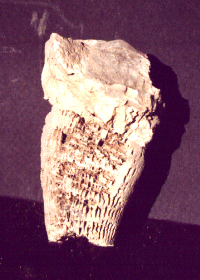Rugose Coral
Age: Ordovician
Formation: Farr
 Rugose corals are a subclass of the Phylum Cnidaria. They ranged from the Ordovician through the Permian. Often called horn corals, cup corals or tetracorals, they may be found alone or in colonies, with a solid external skeleton that is easily fossilized. Their basic shape is that of an inverted cone. They usually display well-developed radial septa in the calice, and less well developed transverse plates (or platforms) under the calice.
Rugose corals are a subclass of the Phylum Cnidaria. They ranged from the Ordovician through the Permian. Often called horn corals, cup corals or tetracorals, they may be found alone or in colonies, with a solid external skeleton that is easily fossilized. Their basic shape is that of an inverted cone. They usually display well-developed radial septa in the calice, and less well developed transverse plates (or platforms) under the calice.
Long septa usually alternate with short ones. The rugose corals are also known as tetracorals, as the septa are inserted in groups of four. The pattern of septa introduction can be seen in the photos presented here. Each separate "chamber" is known as a corallite, and is composed of either the thickened bases of the septa or small, arched plates inclined toward the center of the cone.
 Advance One Slide
Advance One Slide
 Go Back One Slide
Go Back One Slide